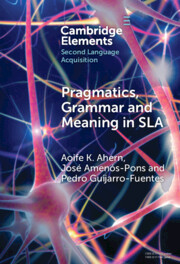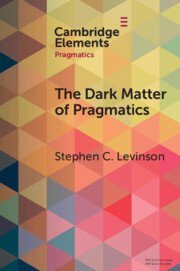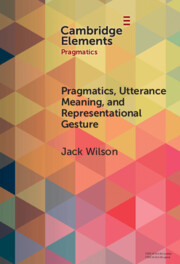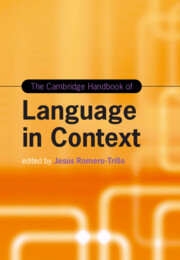156 results
5 - Context and Pragmatics
-
- Book:
- The Philosophy of Theoretical Linguistics
- Published online:
- 25 April 2024
- Print publication:
- 02 May 2024, pp 108-136
-
- Chapter
- Export citation

Pragmatics, Grammar and Meaning in SLA
-
- Published online:
- 29 March 2024
- Print publication:
- 18 April 2024
-
- Element
- Export citation
1 - Introduction
-
- Book:
- Ritual and Language
- Published online:
- 07 March 2024
- Print publication:
- 28 March 2024, pp 1-10
-
- Chapter
- Export citation
7 - Semantics and Pragmatics: Compositionality and the Relation between Grammar and Meaning
-
- Book:
- Modern Linguistics in Ancient India
- Published online:
- 14 March 2024
- Print publication:
- 21 March 2024, pp 165-187
-
- Chapter
- Export citation

The Dark Matter of Pragmatics
- Known Unknowns
-
- Published online:
- 12 March 2024
- Print publication:
- 11 April 2024
-
- Element
-
- You have access
- Open access
- HTML
- Export citation
Pragmatic effects on the sentence-final intonation of answered wh-in-situ questions in French
-
- Journal:
- Journal of French Language Studies , First View
- Published online by Cambridge University Press:
- 23 February 2024, pp. 1-23
-
- Article
-
- You have access
- Open access
- HTML
- Export citation

Pragmatics, Utterance Meaning, and Representational Gesture
-
- Published online:
- 02 February 2024
- Print publication:
- 29 February 2024
-
- Element
- Export citation
Diminutive names in Peninsular Arabic
-
- Journal:
- Bulletin of the School of Oriental and African Studies / Volume 87 / Issue 1 / February 2024
- Published online by Cambridge University Press:
- 12 January 2024, pp. 69-85
- Print publication:
- February 2024
-
- Article
-
- You have access
- Open access
- HTML
- Export citation
8 - Pragmatics and Emotion
-
- Book:
- Pragmatics and Emotion
- Published online:
- 13 December 2023
- Print publication:
- 21 December 2023, pp 144-148
-
- Chapter
- Export citation
2 - Pragmatics and Emotion
-
- Book:
- Pragmatics and Emotion
- Published online:
- 13 December 2023
- Print publication:
- 21 December 2023, pp 13-28
-
- Chapter
- Export citation
14 - Prosodic Pragmatics in Context
- from Part III - Pragmatic Approaches to Context
-
-
- Book:
- The Cambridge Handbook of Language in Context
- Published online:
- 30 November 2023
- Print publication:
- 14 December 2023, pp 314-328
-
- Chapter
- Export citation
13 - Corpus Pragmatics
- from Part III - Pragmatic Approaches to Context
-
-
- Book:
- The Cambridge Handbook of Language in Context
- Published online:
- 30 November 2023
- Print publication:
- 14 December 2023, pp 289-313
-
- Chapter
- Export citation
4 - Philosophy of Language and Action Theory
- from Part II - Philosophical, Semantic, and Grammatical Approaches to Context
-
-
- Book:
- The Cambridge Handbook of Language in Context
- Published online:
- 30 November 2023
- Print publication:
- 14 December 2023, pp 95-115
-
- Chapter
- Export citation

Pragmatics and Emotion
-
- Published online:
- 13 December 2023
- Print publication:
- 21 December 2023

The Cambridge Handbook of Language in Context
-
- Published online:
- 30 November 2023
- Print publication:
- 14 December 2023
1 - Pragmatics, Politeness, and Chinese Politeness
-
- Book:
- Chinese Politeness
- Published online:
- 02 November 2023
- Print publication:
- 16 November 2023, pp 1-12
-
- Chapter
- Export citation
6 - Does Everyone Use Grammar to Make Social Meaning?
-
- Book:
- Socio-syntax
- Published online:
- 19 October 2023
- Print publication:
- 02 November 2023, pp 138-170
-
- Chapter
- Export citation
7 - How Does Grammar Combine with Other Elements of Language?
-
- Book:
- Socio-syntax
- Published online:
- 19 October 2023
- Print publication:
- 02 November 2023, pp 171-206
-
- Chapter
- Export citation
3 - How Do We Study the Social Meaning of Grammatical Variation?
-
- Book:
- Socio-syntax
- Published online:
- 19 October 2023
- Print publication:
- 02 November 2023, pp 46-74
-
- Chapter
- Export citation
8 - What Does It Mean to View Grammar as a Fluid, Flexible Social Resource?
-
- Book:
- Socio-syntax
- Published online:
- 19 October 2023
- Print publication:
- 02 November 2023, pp 207-232
-
- Chapter
- Export citation



